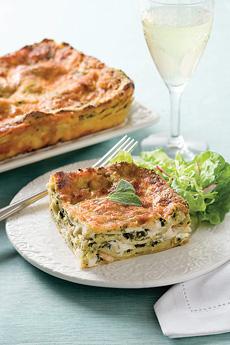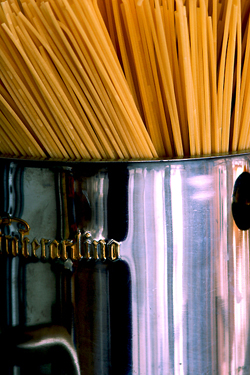

With roots dating back to ancient Rome, lasagne has become an American favorite. Photo courtesy CBCrabcakes.com.
October 2007
Last Updated February 2012
|
 |
Pasta Origin
Page 5: Pasta Goes Mainstream
This is Page 5 of a five-page article on pasta origin; here, the mainstreaming of pasta in America. Click on the black links below to visit other pages.
The Mainstreaming Of Pasta
Although hundreds of small pasta factories opened in America’s Little Italys, Italians preferred to buy imported pasta, however expensive, because it was made from durum wheat. (American farmers did not grow durum until the 20th century.)
It’s easy to chart the subsequent quick growth of pasta. Some highlights:
- In the 1890s, the Franco-American brand of canned spaghetti was launched.
- World War I (1914 to 1918) brought imports to a halt, and the number of American pasta-makers rose from 373 to 557.
- Pasta was inexpensive at a time when food prices were rising. Recipes for spaghetti and tomato sauce started turning up in women’s magazines.
- Millers sponsored “eat more wheat” campaigns in the early 1920s. Pasta manufacturers began to use durum, which they advertised as being higher in protein than soft wheat (it is, but not by much).
- Campbell’s, Heinz and other manufacturers brought out canned macaroni with tomato sauce.
- In 1927, Kraft introduced grated parmesan cheese in a cardboard container with a perforated top, as a topping for spaghetti with tomato sauce.
- Cafeterias became very popular in the 1920s, and spaghetti and tomato sauce was a hot item. Italians nationwide opened “spaghetti houses” to serve blue-collar workers. By the end of the decade, the Italian restaurant had become the most popular type of ethnic restaurant in America, a position it still holds.
|
|

Spaghetti waiting to be cooked. Photo
by Clara Neroli | Morguefile. |
- The Great Depression of the 1930s made inexpensive food like spaghetti a necessity. Spaghetti and meatballs began to appear regularly on millions of American tables.
- Today pasta is a completely versatile food: from school cafeteria to the most exclusive restaurant, from main course to side to dessert, it fills any need asked of it.
And today durum wheat is a huge American crop: More than 100 million bushels are produced annually, largely in North Dakota.
According to the National Pasta Association, America manufactures more pasta than any other country in the world—more than five billion pounds a year. In 2000, five billion pounds of pasta were produced: 4.5 billion in dry pasta and .5 billion in frozen and fresh pasta.
In terms of being an “American” food: macaroni and cheese made the list of the top 10 foods of the century, according to an article in the Sacramento Bee that polled authorities on the foods most representative of American cooking in the 1900s³.
Spaghetti and meatballs did not make the list.
³The ten top foods are apple pie, barbecue, chili, chocolate chip cookies, fried chicken, hamburger/cheeseburger, Jell-O, macaroni and cheese, pancakes and pizza.
Go To The Article Index Above
Content copyright © 2005-

|



